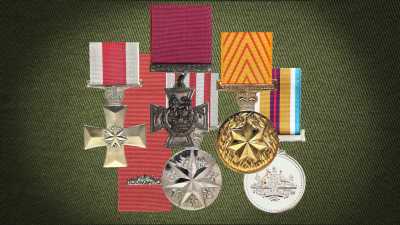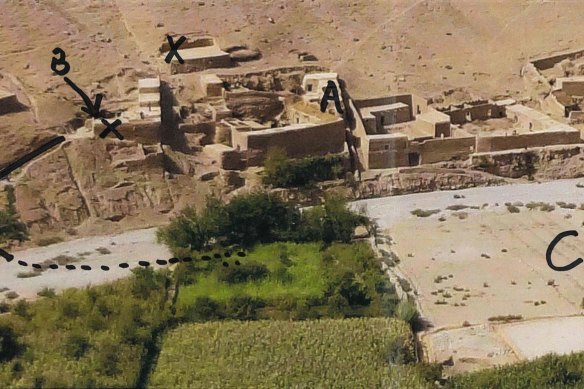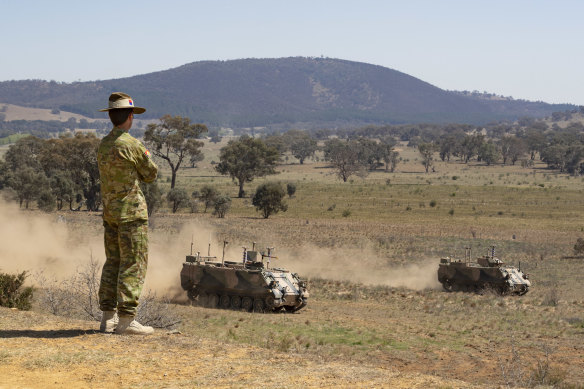Reputation over rank: Where was the command over this culture?

By Chris Masters
Credit: Jamie Brown
Save articles for later
Add articles to your saved list and come back to them any time.
The question of command accountability for Australian war crimes in Afghanistan was never going to be addressed in the Ben Roberts-Smith defamation trial.
The central issue for that case was whether we reported the truth on murders committed, directly or indirectly, by a corporal. The court agreed that we had proved four.
But there were insights on officers’ involvement, knowledge and responsibility from the testimony of the 41 witnesses. Six officers appeared among them, just one with command responsibility outside the wire that separated Australian bases from the warring badlands outside.
Designated by the court as Person 81, the then-captain commanded the 2009 mission to the Whiskey 108 compound, where we reported, and the federal court agree we proved, that two executions occurred.
Subpoenaed for Ben Roberts-Smith, Person 81 saw no misconduct on that day and heard nothing about alleged war crimes until after the Inspector General Inquiry, headed by Major General Paul Brereton, began in 2016.
His evidence is not in dispute but stands in contrast to the testimony of seven soldiers under his command on that day.
Three soldiers had eyes on murders, which one described as an “exhibition execution”. Another exposed to two killings had kept his silence until fronting the witness box because he believed that is what the SAS brotherhood expected.
The other central allegation – of a notorious cliff-kicking murder at Darwan in 2012 – was closer to the pattern of how we came to believe most unlawful killings occurred.
An exhibit in the Ben Roberts-Smith defamation case, showing the village of Darwan. The “X” marked with “B” and an arrow is said to be the cliff from which a villager was allegedly kicked by Roberts-Smith.
When Ben Roberts-Smith booted Ali Jan off the cliff, there were no officers nearby. Afghans were around, but the only other Australians present were two members of Roberts-Smith’s patrol.
As shocking as the events now seem, far removed from the war environment, they were not to those on the ground.
By the last phase of the longest war, we came to suspect unlawful killings were relatively common, driven by widespread de-sensitisation and an informal logic that prospective combatants should not be left alive.
Usually killings were done under cover, inside a building where no peering eyes from aerial surveillance could reach.
Weapons were then planted on the victims to validate the killings and photographs taken. In this respect, Darwan was also unusual. There was a tactical headquarters post set up in a position to keep an eye on the fighting.
Helicopters were in the air, as was a Heron drone. That is not to say the kick and the execution were observed by anyone other than three Australian soldiers and a group of Afghans. But they were talked about.
When the taskforce returned to Camp Russell, the Australian base at regional capital Tarin Kowt, the extraordinary cliff kick execution – straight from the Spartan legend and macho fantastico film 300 – was part of the buzz.
Evidence was given that not only was it discussed, but a stick figure of a man being kicked off a cliff by a “winged penis” was drawn and posted in headquarters.
The winged penis was an in-joke caricature of the Special Air Service’s famed winged dagger.
More evidence was given of another buzz, a sub-current of concern about summary executions sweeping the ranks even before Ben Roberts-Smith VC MG deployed to Afghanistan in 2012.
Trained on his colleagues
Going back to his predeployment days in training north of Perth, Roberts-Smith was heard during an exercise to order one of his troopers to “shoot” a bound detainee.
The mock execution was observed by two sergeants who later admonished the newly anointed patrol commander. Two members of Roberts-Smith’s patrol, including the trooper known to the court as Person 10, who was ordered to pull the trigger, confirmed the mock execution.
Their patrol commander was remembered telling them: “Are you good with that, because that’s how it is going to be when we get over there.”
One soldier, designated Person 19, said Roberts-Smith reinforced the instruction in further training, identifying the need to move any overhead surveillance drones away from their location, and keep officers outside the compounds when they were about to execute a detainee.
Another meeting at a Perth cafe soon after the training incident was even more telling.
Here Roberts-Smith told Person 19 of his intention to have Person 10 “blooded”, that is, be acculturated into killing, because he “needed to prove himself”.
“Can you believe that bullshit,” Person 19 said he told Person 10 after the mock execution episode.
He also said the practice of people being dragged into rooms and shot was widely discussed throughout his time in the unit.
So this was a hot topic, particularly among junior soldiers, but should we believe it was unknown to anyone in command?
When the ABC’s Mark Willacy aired footage of an unarmed Afghan being shot dead in 2012, what alarmed many in senior leadership here in Australia was the apparent indifference of the onlookers.
At least four soldiers were in full view of the shooter, one a sergeant and an experienced patrol commander.
In the sorry final stages of the Afghanistan conflict there are strong indications that coalition special forces developed a similar regard for FAMs or fighting aged males in a combat zone. They were considered targets, irrespective of whether they represented any apparent threat.
In his inquiry Brereton found that it was sergeants, corporals and lower ranks who pulled the trigger in these incidents – feeling unencumbered by their official orders from above. Often these soldiers, particularly in the SAS, had commendations and were respected by their units which gave them a sense of protection.
Over the years, esteem began to outstrip rank. Experience and reputation could determine who was really in charge in the field.
The prospect of less experienced officers seeking the respect of the boys by becoming one of them, has long been a problem for SASR.
The Ben Roberts-Smith training day edict to junior soldiers of shooting captured Afghans was never something to be found in an infantry field manual.
The big question is, did it become subconsciously accepted while consciously disavowed, by some officers in the field? Whatever the case it should be understood, with SASR there weren’t many officers in the field.
Over time, experienced corporals and sergeants became adept at ensuring officers were kept, as they put it, “a tactical bound away”.
The rationale was having officers slightly removed from the combat zone helped with higher-level coordination and minimised the chance of the boss getting in the way. But as all those in command are forced to acknowledge, ignorance is no excuse.
When rumour of war crimes hardened into evidence through the Brereton inquiry process, senior leadership confronted a frightening recognition of widespread suspension of curiosity.
Of course, you can’t say leadership completely failed, given the initiation of that inquiry, thanks largely to then Special Operations Commander, Major General Jeff Sengelman, and some soldiers who spoke up.
But that was 2016, 10 years after the first murmurs of disquiet. It was a full decade after Ben Roberts-Smith threatened to shoot a junior soldier in the back of the head at the incident where he won a gallantry medal, the start of a decade of relentless bullying. That bullying was reported to senior command years in 2013.
The defamation action did manage to unmask many moments when efforts were made to elevate concerns of misconduct – and war crimes. In fact, it is the first time solid public insights can be grasped about soldiers’ efforts to report those crimes. While we now realise there were small groups in the know, there were also large barriers to corporate knowledge.
Putting the puzzle together
How those barriers were overcome is important and still not well understood.
It was only when Australia essentially packed up and left Afghanistan in 2013 that concerned parties began putting the pieces together.
Special Forces loves exclusivity and the quarantining of intelligence. Ben Roberts-Smith’s five-or six-man patrol was designed for discrete operations. So, despite the clues of winged penises and the like, most of what came to be understood about war crimes in Afghanistan was figured out later, back in Australia.
As was revealed in the trial, around April 2013 four sergeants knocked on the Regimental Sergeant Major’s (RSM’s) office door at Perth’s Campbell Barracks.
Evidence was given about them complaining about Roberts-Smith’s bullying, the merit of his Victoria Cross – and war crimes.
The then RSM, later promoted to Captain and then Major and designated by the court as Person 100, disputed there had been any mention of war crimes.
A few days after that first 2013 meeting, four corporals then fronted the same RSM. And evidence was given that similar complaints were made.
Again, the RSM disputed there was any discussion of alleged war crimes. He said after both meetings he referred the concerns upward to his commanding officer.
He told counsel for Ben Roberts-Smith he could not access records of the meetings as they were restricted to the Defence Secret Network.
In cross-examination, Nicholas Owens SC put to the former RSM that he “did not want to have allegations of serious misconduct against Mr Roberts-Smith investigated in 2013 because you thought it would reflect poorly on the reputation of the regiment”.
The witness replied, “That’s not correct sir”.
We presume the Australian Defence Force can access its own secret records to identify any weak links in chain of command communications.
Also of interest is the chain of communication recommending Ben Roberts-Smith’s Commendation for Distinguished Service.
The awarding of a medal for exemplary leadership came as a shock to other patrol commanders who in 2014 made a further official complaint.
When in November 2020, Justice Paul Brereton found credible information of war crimes, referring 36 matters to the Australian Federal Police, he addressed command accountability.
In identifying what went wrong there was further recognition of problems closer to home, in Australia rather than Afghanistan.
“Some domestic commanders of Special Air Service Regiment bear significant responsibility for contributing to the environment in which war crimes were committed, most notably those who embraced or fostered the ‘warrior culture’ and empowered or did not restrain the clique of non-commissioned officers who propagated it,” Brereton’s report finds.
The question of holding leadership of the Special Forces Afghanistan mission to account remains vexed. Brereton, a lawyer, found no direct, actionable evidence of complicity in wrongdoing from higher ranks.
After findings that exclusively punished junior soldiers, there was public clamour, particularly in tabloid media, for higher ranking scalps.
A great many commanders could not have been sacked anyway, because they had moved on. Sacking those who remained without clear evidence of wrongdoing presented obvious procedural fairness problems.
The refrain that nothing was yet proved ] also acted as a kind of stay of execution.
However, as Brereton also reported, “the absence of knowledge or even suspicion that war crimes were being committed by some of their subordinates does not relieve commanders of all responsibility”.
Where does responsibility sit?
If strictly applied, this criterion of accountability would take out a great many officers including the man who commissioned the inquiry, Defence Chief Angus Campbell, who was also Australian commander in of Middle East area of operations in 2011.
His role was held up to scrutiny in senate hearings in late May with soldier-turned-politicians Jacqui Lambie loudly calling for Campbell to be stripped of his medal.
One officer whose career did end was one of the few remaining in senior leadership with an Afghanistan service history.
Ian Langford is one of the officers involved.Credit: Defence Department
Brigadier Ian Langford had the misfortune to command the newly anointed Victoria Cross recipients’ 2012 rotation.
The then Commando Lieutenant Colonel Langford, who never went into the SAS drinking hole The Fat Lady’s Arms, was not considered at fault by Brereton.
This is not hard to believe considering that SAS officers who did choose to drink with the boys, and had more direct command accountability, faced no sanction.
There is still some anger in the ranks close to Langford, who suspect he was shown the door to avoid the prospect of embarrassing news coverage.
The highly respected officer was just short of an elevation to Major General. When he was told he would not be promoted he was offered a redundancy and has since resigned.
Following the Brereton revelations Langford tried to return the Distinguished Service Cross he was awarded for leadership after that ill-fated rotation.
The offer was at that stage rejected on the grounds there was not a process for the revocation of medals and the Office of the Special Investigator was yet to make findings.
Now, the opportunity for a dignified reconciliation is lost, with Langford and others have receiving notices asking why their medals should not be revoked.
One of these medals might be Ben Roberts-Smith’s Commendation for Distinguished Service. Some, however, can continue to wear them with pride.
Former SAS captain and current shadow Defence Minister Andrew Hastie gave evidence in the defamation action that he had a “gut feeling” something was wrong, on a mission where Roberts-Smith was later alleged to have “blooded” a subordinate, by executing an Afghan detainee.
He was challenged by Roberts-Smith’s counsel for attending to feelings born of rumour and suspicion.
Yet those feelings, too often absent within the officer corps, seem exactly what was needed.
The Morning Edition newsletter is our guide to the day’s most important and interesting stories, analysis and insights. Sign up here.
Most Viewed in National
Source: Read Full Article

